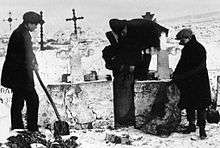Political repression in the Soviet Union
Throughout the history of the Soviet Union, millions of people suffered political repression, which was an instrument of the state since the October Revolution. It culminated during the Stalin era, then declined, but it continued to exist during the "Khrushchev Thaw", followed by increased persecution of Soviet dissidents during the Brezhnev stagnation, and it did not cease to exist until late in Mikhail Gorbachev's rule when it was ended in keeping with his policies of glasnost and perestroika.
| This article is part of a series on the |
| Politics of the Soviet Union |
|---|
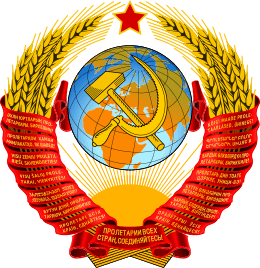 |
|
Leadership |
|
Governance |
Origins and early Soviet times

Secret police had a long history in Russia. Ivan the Terrible used the Oprichina, while more recently the Third Section and Okrhana.
| Mass repression in the Soviet Union |
|---|
| Economic repression |
| Political repression |
| Ideological repression |
|
| Ethnic repression |
|
Early on, the Leninist view of the class conflict and the resulting notion of the dictatorship of the proletariat provided the theoretical basis of the repressions. Its legal basis was formalized into the Article 58 in the code of Russian SFSR and similar articles for other Soviet republics.
At times, the repressed were called the enemies of the people. Punishments by the state included summary executions, sending innocent people to Gulag, forced resettlement, and stripping of citizen's rights. At certain times, all members of a family, including children, were punished as "traitor of the Motherland family-members". Repression was conducted by the Cheka and its successors, and other state organs. Periods of the increased repression include Red Terror, Collectivisation, the Great Purges, the Doctor's Plot, and others. The secret-police forces conducted massacres of prisoners on numerous occasions. Repression took place in the Soviet republics and in the territories occupied by the Soviet Army during World War II, including the Baltic States and Eastern Europe.[1].
State repression led to incidents of resistance, such as the Tambov rebellion (1920–1921), the Kronstadt rebellion (1921), and the Vorkuta Uprising (1953); the Soviet authorities suppressed such resistance with overwhelming military force. During the Tambov rebellion Tukhachevsky (chief Red Army commander in the area) allegedly authorized Bolshevik military forces to use chemical weapons against villages with civilian population and rebels. (According to witnesses' accounts, chemical weapons were never actually used.[2]) Prominent citizens of villages were often taken as hostages and executed if the resistance fighters did not surrender.[3]
Red Terror
Red Terror in Soviet Russia was the campaign of mass arrests and executions conducted by the Bolshevik government. The Red Terror was officially announced on September 2, 1918 by Yakov Sverdlov and ended in about October 1918. However Sergei Melgunov applies this term to repressions for the whole period of the Russian Civil War, 1918–1922.[4][5] Estimates for the total number of people executed during the initial phase Red Terror are at least 10,000, with roughly 28,000 executed per year between December 1917 and February 1922.[6] Estimates for the total number of lives lost during this period range from 100,000[7] to 200,000.[8]
Collectivization
Collectivization in the Soviet Union was a policy, pursued between 1928 and 1933, to consolidate individual land and labour into collective farms (Russian: колхо́з, kolkhoz, plural kolkhozy). The Soviet leaders were confident that the replacement of individual peasant farms by kolkhozy would immediately increase food supplies for the urban population, the supply of raw materials for processing industry, and agricultural exports generally. Collectivization was thus regarded as the solution to the crisis in agricultural distribution (mainly in grain deliveries) that had developed since 1927 and was becoming more acute as the Soviet Union pressed ahead with its ambitious industrialization program.[9] As the peasantry, with the exception of the poorest part, resisted the collectivization policy, the Soviet government resorted to harsh measures to force the farmers to collectivize. In his conversation with Winston Churchill Stalin gave his estimate of the number of "kulaks" who were repressed for resisting Soviet collectivization as 10 million, including those forcibly deported.[10][11] Recent historians have estimated the death toll in the range of six to 13 million.[12]
| Mass repression in the Soviet Union |
|---|
| Economic repression |
| Political repression |
| Ideological repression |
|
| Ethnic repression |
|
Great Purge

The Great Purge (Russian: Большая чистка, transliterated Bolshaya chistka) was a series of campaigns of political repression and persecution in the Soviet Union orchestrated by Joseph Stalin in 1937–1938.[13][14] It involved the purge of the Communist Party of the Soviet Union, repression of peasants, deportations of ethnic minorities, and the persecution of unaffiliated persons, characterized by widespread police surveillance, widespread suspicion of "saboteurs", imprisonment, and killings.[13] Estimates of the number of deaths associated with the Great Purge run from the official figure of 681,692 to nearly 1 million.
Genocide, ethnic cleansing and population transfers
In the Soviet Union, political repressions not only targeted individual persons, but they also targeted whole ethnic, social and religious groups as well as other categories within the Soviet population.
Population transfer in the Soviet Union may be divided into the following broad categories: deportations of "anti-Soviet" categories within the population, who were often classified as "enemies of the workers"; deportations of nationalities; labor force transfer; and organised migrations in opposite directions in order to fill the ethnically cleansed territories. In most cases their destinations were underpopulated and remote areas (see Involuntary settlements in the Soviet Union).
Entire nations and ethnic groups were collectively punished by the Soviet Government for their alleged collaboration with the enemy during World War II. At least nine distinct ethnic-linguistic groups, including ethnic Germans, ethnic Greeks, ethnic Poles, Crimean Tatars, Balkars, Chechens, and Kalmyks, were deported to remote and unpopulated areas of Siberia (see sybirak) and Kazakhstan. Population transfer in the Soviet Union led to millions of deaths that resulted from the hardships that it inflicted upon its victims.[15] Koreans and Romanians were also deported. Mass operations of the NKVD were needed to deport hundreds of thousands of people.
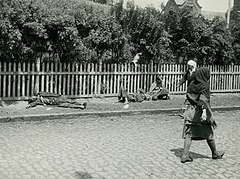
The Soviet famine of 1932–1933 was severely aggravated by the actions of the government of the Soviet Union, such as its confiscation of food, the lack of meat, planned delivery limitations which ignored the consequences of the famine, blocking the migration of its starving population, and the suppression of information about the famine, all of which prevented any organized relief effort. This led to the death of millions of people in the affected areas.[15] The overall number of victims who perished during the 1932–1933 famine is variously estimated to be 6–7 million people Soviet-wide[16] or 6–8 million.[17]
Gulag
The Gulag "was the branch of the State Security that operated the penal system of forced labour camps and associated detention and transit camps and prisons. While these camps housed criminals of all types, the Gulag system has become primarily known as a place for political prisoners and as a mechanism for repressing political opposition to the Soviet state."[18][19] Russian author and former prisoner Aleksandr Solzhenitsyn wrote extensively about the gulag and its history in his series of books The Gulag Archipelago.
Repressions in annexed territories
During the early years of World War II Soviet Union annexed several territories in East Europe as the consequence of the German–Soviet Pact and its Secret Additional Protocol.[20]
Baltic States
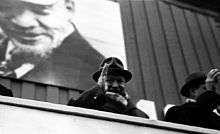
In the Baltic countries of Estonia, Latvia and Lithuania, repressions and the mass deportations were carried out by the Soviets. The Serov Instructions, "On the Procedure for carrying out the Deportation of Anti-Soviet Elements from Lithuania, Latvia, and Estonia", contained detailed procedures and protocols to observe in the deportation of Baltic nationals. Public tribunals were also set up to punish "traitors to the people": those who had fallen short of the "political duty" of voting their countries into the USSR. In the first year of Soviet occupation, from June 1940 to June 1941, the number confirmed executed, conscripted, or deported is estimated at a minimum of 124,467: 59,732 in Estonia, 34,250 in Latvia, and 30,485 in Lithuania.[22] This included 8 former heads of state and 38 ministers from Estonia, 3 former heads of state and 15 ministers from Latvia, and the then president, 5 prime ministers and 24 other ministers from Lithuania.[23]
Poland
Romania
Post-Stalin era (1953–1991)
After Stalin's death, the suppression of dissent was dramatically reduced and took new forms. The internal critics of the system were convicted for anti-Soviet agitation, Anti-Soviet slander, or as "social parasites". Others were labeled as mentally ill, having sluggish schizophrenia and incarcerated in "psikhushkas", i.e. mental hospitals used by the Soviet authorities as prisons.[24] A number of notable dissidents, including Aleksandr Solzhenitsyn, Vladimir Bukovsky, and Andrei Sakharov, were sent to internal or external exile.
Loss of life
.jpg)
Estimates of the number of deaths attributable to Joseph Stalin vary widely. Some scholars assert that record-keeping of the executions of political prisoners and ethnic minorities are neither reliable nor complete,[25] others contend archival materials contain irrefutable data far superior to sources utilized prior to 1991, such as statements from emigres and other informants.[26][27] Those historians working after the Soviet Union's dissolution have estimated victim totals ranging from approximately 3 million[28] to nearly 9 million.[29] Some scholars still assert that the death toll could be in the tens of millions.[30]
Counting the Loss
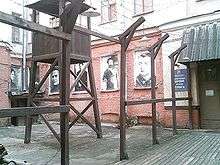
In 2011, the historian Timothy D. Snyder, after assessing 20 years of historical research in Eastern European archives, asserts that Stalin deliberately killed about 6 million (rising to 9 million if foreseeable deaths arising from policies are taken into account)[31][29]
The release of previously secret reports from the Soviet archives in the 1990s indicate that the victims of repression in the Stalin era were about 9 million persons. Some historians claim that the death toll was around 20 million based on their own demographic analysis and from dated information published before the release of the reports from the Soviet archives. American historian Richard Pipes noted: "Censuses revealed that between 1932 and 1939—that is, after collectivization but before World War II—the population decreased by 9 to 10 million people.[32] In his most recent edition of The Great Terror (2007), Robert Conquest states that while exact numbers may never be known with complete certainty, at least 15 million people were killed "by the whole range of Soviet regime's terrors".[33] Rudolph Rummel in 2006 said that the earlier higher victim total estimates are correct, although he includes those killed by the government of the Soviet Union in other Eastern European countries as well.[34] Conversely, J. Arch Getty, Stephen G. Wheatcroft and others insist that the opening of the Soviet archives has vindicated the lower estimates put forth by "revisionist" scholars.[28][35] Simon Sebag Montefiore in 2003 suggested that Stalin was ultimately responsible for the deaths of at least 20 million people[36]
Some of these estimates rely in part on demographic losses. Conquest explained how he arrived at his estimate: "I suggest about eleven million by the beginning of 1937, and about three million over the period 1937–38, making fourteen million. The eleven-odd million is readily deduced from the undisputed population deficit shown in the suppressed census of January 1937, of fifteen to sixteen million, by making reasonable assumptions about how this was divided between birth deficit and deaths."[37]
Some historians also believe that the official archival figures of the categories that were recorded by Soviet authorities are unreliable and incomplete.[25] In addition to failures regarding comprehensive recordings, as one additional example, Canadian historian Robert Gellately and British historian Simon Sebag Montefiore argue that the many suspects beaten and tortured to death while in "investigative custody" were likely not to have been counted amongst the executed.Conversely, Australian historian Stephen G. Wheatcroft asserts that prior to the opening of the archives for historical research, "our understanding of the scale and the nature of Soviet repression has been extremely poor" and that some specialists who wish to maintain earlier high estimates of the Stalinist death toll are "finding it difficult to adapt to the new circumstances when the archives are open and when there are plenty of irrefutable data" and instead "hang on to their old Sovietological methods with round-about calculations based on odd statements from emigres and other informants who are supposed to have superior knowledge".[27]
Remembering the victims
_-_59.jpg)
A Day of Remembrance for the Victims of Political Repression (День памяти жертв политических репрессий) has been officially held on 30 October in Russia since 1991. It is also marked in other former Soviet republics with the exception of Ukraine, which has its own annual Day of Remembrance for the victims of political repressions by the Soviet regime, held each year on the third Sunday of May.
Members of the Memorial society have taken an active part in such commemorative meetings. Since 2007 Memorial has also organised the day-long "Restoring the Names" ceremony at the Solovetsky Stone in Moscow every 29 October.[38]
The Wall of Grief in Moscow, inaugurated in October 2017, is Russia's first monument ordered by presidential decree for people killed during the Stalinist repressions in the Soviet Union.[39][40]
See also
- Active measures
- Human rights in the Soviet Union
- Rehabilitation (Soviet)
- Soviet political system
- Soviet law
- Soviet repression in Belarus
- Goli otok
- Hitler Youth Conspiracy
- Mass killings under Communist regimes
- USSR anti-religious campaign (1970s–1990)
- The Black Book of Communism
References
Notes
- Anton Antonov-Ovseenko Beria (Russian) Moscow, AST, 1999. Russian text online
- Химико-политический туман (Chemical Political Fog) by Alexander Shirokorad.
- Courtois et al, 1999:
- Serge Petrovich Melgunov, Red Terror in Russia, Hyperion Pr (1975), ISBN 0-88355-187-X
- Courtois et al., 1999:
- Ryan 2012, pp. 114,2.
- Lincoln, W. Bruce (1989). Red Victory: A History of the Russian Civil War. Simon & Schuster. p. 384. ISBN 978-0671631666.
...the best estimates set the probable number of executions at about a hundred thousand.
- Lowe (2002), p. 151.
- Davies, R.W., The Soviet Collective Farms, 1929–1930, Macmillan, London (1980), p. 1.
- Valentin Berezhkov, "Kak ya stal perevodchikom Stalina", Moscow, DEM, 1993, ISBN 5-85207-044-0. p. 317
- Stanislav Kulchytsky, "How many of us perished in Holodomor in 1933" Archived 2006-07-21 at the Wayback Machine, Zerkalo Nedeli, November 23–29, 2002.
- Constantin Iordachi; Arnd Bauerkamper (2014). The Collectivization of Agriculture in Communist Eastern Europe: Comparison and Entanglements. Central European University Press. p. 9. ISBN 9786155225635.
- Figes, 2007: pp. 227–315
- Lenin, Stalin, and Hitler: The Age of Social Catastrophe. By Robert Gellately. 2007. Knopf. 720 pages ISBN 1-4000-4005-1
- Conquest, 1986:
- С. Уиткрофт (Stephen G. Wheatcroft), "О демографических свидетельствах трагедии советской деревни в 1931—1933 гг." Archived 2008-03-20 at the Wayback Machine (On demographic evidence of the tragedy of the Soviet village in 1931-1833), "Трагедия советской деревни: Коллективизация и раскулачивание 1927–1939 гг.: Документы и материалы. Том 3. Конец 1930–1933 гг.", Российская политическая энциклопедия, 2001, ISBN 5-8243-0225-1, с. 885, Приложение № 2
- "Ukraine", Encyclopædia Britannica, 2008.
- Anne Applebaum (2003). Gulag: A History. Doubleday. ISBN 978-0767900560.
- Robert Service (June 7, 2003). "The accountancy of pain". The Guardian.
- The Soviet occupation and incorporation at Encyclopædia Britannica
- Roszkowski, Wojciech (2016). Biographical Dictionary of Central and Eastern Europe in the Twentieth Century. Routledge. p. 2549. ISBN 978-1317475934.
- Dunsdorfs, Edgars. The Baltic Dilemma. Speller & Sons, New York. 1975
- Küng, Andres. Communism and Crimes against Humanity in the Baltic States. 1999 "Archived copy". Archived from the original on 2001-03-01. Retrieved 2015-02-17.CS1 maint: archived copy as title (link)
- The Soviet Case: Prelude to a Global Consensus on Psychiatry and Human Rights. Human Rights Watch. 2005
- "SOVIET STUDIES". sovietinfo.tripod.com. Retrieved 2019-05-28.
- "The Scale and Nature of German and Soviet Repression and Mass Killings,1930-45" (PDF).
- "The Scale and Nature of Stalinist Repression" (PDF).
- "Victims of the Soviet Penal System in the Pre-war Years:A First Approach on the Basis of Archival Evidence". Archived from the original on 2008-06-11.
- Snyder, Timothy (2011-01-27). "Hitler vs. Stalin: Who Was Worse?". The New York Review of Books. Retrieved 2019-05-28.
- Rosefielde, Steven (2008). Red Holocaust. Routledge. p. 17. ISBN 978-0-415-77757-5.
- Snyder, Timothy (2010). Bloodlands: Europe between Hitler and Stalin. New York. p. 384.
- Pipes, Richard (2001). Communism: A History. USA. p. 67.
- Conquest, Robert (2007). The Great Terror: A Reassessment, 40th Anniversary Edition. Oxford University Press. pp. in Preface, p. xvi: "Exact numbers may never be known with complete certainty, but the total of deaths caused by the whole range of Soviet regime's terrors can hardly be lower than some fifteen million.".
- "How Many Did Stalin Really Murder? | The Distributed Republic". www.distributedrepublic.net. Retrieved 2019-05-28.
- "Victims of Stalinism" (PDF).
- Montefiore, Simon Sebag (2007-12-18). Stalin: The Court of the Red Tsar. Knopf Doubleday Publishing Group. p. 643. ISBN 9780307427939.
- "Robert Conquest, Excess Deaths in the Soviet Union, NLR I/219, September–October 1996". New Left Review. Retrieved 2019-05-28.
- "Restoring the Names, Dmitriev Affair website, 30 October 2017.
- "Путин открыл в Москве мемориал "Стена скорби"" [Putin Opened the Memorial "Wall of Grief" in Moscow]. РБК (in Russian). 30 October 2017.
- "Wall of Grief: Putin opens first Soviet victims memorial". BBC News. 30 October 2017.
Bibliography
- Conquest, Robert (1986). The Harvest of Sorrow: Soviet Collectivization and the Terror-Famine. Oxford University Press. ISBN 978-0-19-505180-3.
- Courtois, Stephane; et al., eds. (1999). The Black Book of Communism: Crimes, Terror, Repression. Harvard University Press. ISBN 978-0-674-07608-2.
- Figes, Orlando (2007). The Whisperers: Private Life in Stalin's Russia. Macmillan. ISBN 978-0-8050-7461-1.
- Lindy; Lifton, Robert Jay (2001). Beyond invisible walls: the psychological legacy of Soviet trauma, East European therapists, and their patients. Psychology Press. ISBN 978-1-58391-318-5.
- "New directions in Gulag studies: a roundtable discussion," Canadian Slavonic Papers 59, no 3-4 (2017)
- Nove, Alec (1993). "Victims of Stalinism: How Many?". In Getty, J. Arch; Manning, Roberta T. (eds.). Stalinist Terror: New Perspectives. Cambridge University Press. ISBN 978-0-521-44670-9.
- Ryan, James (2012). Lenin's Terror: The Ideological Origins of Early Soviet State Violence. London: Routledge. ISBN 978-1138815681.CS1 maint: ref=harv (link)
- Wheatcroft, Stephen (1996). "The Scale and Nature of German and Soviet Repression and Mass Killings, 1930–45" (PDF). Europe-Asia Studies. 48 (8): 1319–1353. doi:10.1080/09668139608412415. JSTOR 152781.CS1 maint: ref=harv (link)
- Lynne Viola, "New sources on Soviet perpetrators of mass repression: a research note," Canadian Slavonic Papers 60, no 3-4 (2018)
Further reading
- Brooks, Jeffrey (2000). Thank you, comrade Stalin!: Soviet public culture from revolution to Cold War. Princeton University Press. ISBN 978-0-691-00411-2.
- Davies, Robert; Wheatcroft, Stephen (2009). The Industrialisation of Soviet Russia Volume 5: The Years of Hunger: Soviet Agriculture 1931–1933. Palgrave Macmillan UK. ISBN 978-0-230-27397-9.
- Ellman, Michael (November 2002). "Soviet repression statistics: some comments". Europe-Asia Studies. 54 (7): 1151–1172. doi:10.1080/0966813022000017177.
- Eremina, Larisa; Roginsky, Arseny [Лариса Еремина, Арсений Рогинский] (2002). Расстрельные списки: Москва, 1937–1941: "Коммунарка", Бутово: книга памяти жертв политических репрессий [Shot lists: Moscow, 1937–1941: "Kommunarka", Butovo: the book for commemoration of political repression victims] (in Russian). Moscow: Memorial. ISBN 978-5787000597.CS1 maint: multiple names: authors list (link)
- Eremina, Larisa; Roginsky, Arseny [Лариса Еремина, Арсений Рогинский] (2005). Расстрельные списки: Москва, 1935–1953: Донское кладбище (Донской крематорий): книга памяти жертв политических репрессий [Shot lists: Moscow, 1935–1953: the Donskoye cemetery (the Donskoy crematorium): the book for commemoration of political repression victims] (in Russian). Moscow: Memorial. ISBN 978-5787000818.CS1 maint: multiple names: authors list (link)
- Haynes, Michael; Husan, Rumy (2003). A Century Of State Murder? Death and Policy in Twentieth Century Russia. Pluto Press. ISBN 978-0745319308.
- Johns, Michael (Fall 1987). "Seventy years of evil: Soviet crimes from Lenin to Gorbachev". Policy Review: 10–23.
- Leggett, George (1981). The Cheka: Lenin's Political Police. Oxford: Clarendon Press. ISBN 978-0-19-822862-2.
- Medvedev, Roy Aleksandrovich (1985). On Soviet Dissent. Columbia University Press. ISBN 978-0-231-04813-2.
- Rosefielde, Steven (2009). Red Holocaust. Taylor & Francis. ISBN 978-0-415-77757-5.
- Samatan, Marie (1980). Droits de l'homme et répression en URSS: l'appareil et les victimes [Human rights and repression in the USSR: mechanism and victims] (in French). Paris: Seuil. ISBN 978-2020057059.
- Shearer, David R. (2009). Policing Stalin's socialism: repression and social order in the Soviet Union, 1924–1953. Yale University Press. ISBN 978-0-300-14925-8.
- Solomon, Peter H. (1996). Soviet criminal justice under Stalin. Cambridge University Press. ISBN 978-0-521-56451-9.
- Wintrobe, Ronald (2000). The Political Economy of Dictatorship. Cambridge University Press. ISBN 978-0-521-79449-7.
- Александр Подрабинек (2015). Наша кампания за амнистию [Our campaign for amnesty]. Zvezda (in Russian) (4). Retrieved 2 September 2015.
- Zhanbosinova, Albina [Альбина Жанбосинова] (2013). "Политические репрессии в СССР (1920–1950 гг.): историко-статистическое исследование" [Political repression in the USSR (1920–1950s): historical and statistical research] (PDF). European Researcher (in Russian). 45 (4–1): 811–822. Archived (PDF) from the original on 15 November 2015.
- "Political repressions in the USSR". The Andrei Sakharov Museum and Public Center.
